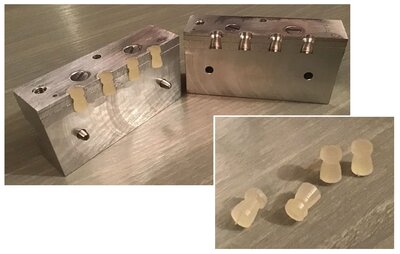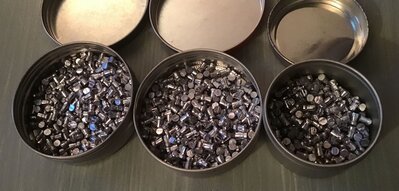Part 2: The beauty of a modular design.
The balance of my mold block was still useable so only a new set of plates needed to be remachined. This time, just to be on the safe side, I made two sets.
After my first attempt (where I made the taper with the Dremel bit) I realized that it was not the ideal tool for aluminum. I decided to machine a custom taper tool from a piece of drill stock.
I started by cutting the tapered shape on the lathe then milling the flutes on the mill. To keep as much material at the root, the part was held in a V block (sitting on an angle bar) to place the tapered profile parallel with the tip of the endmill. I also thought that 3 flutes would be a good compromise between strength and cutting edges. Then I hardened the rod by heating it with a propane torch and quenched it in oil.
I tested the tool on a piece of aluminum in which I already drilled the basic hole that I wanted to taper. I don’t remember now what RPM I used but I guess it was too fast because the result I got was really bad. The tool didn’t want to cut even when a lot of pressure was applied and as a result it ended up being deformed.
When I looked at my countersink bits I discovered that one type had multiple shallow flutes and the other type had a single cutting edge. The other end of my tool was turned to obtain the taper and a single flute was machined on the mill.
The pictures below shows the tool when it was milled (on the left), after quenching (center) and the tool with the single flute on one end and the twisted tip on the opposite end (on the right). It has some residue and rubbing mark because I forgot to take a picture before cutting the cavities in the plates.
Attachment:
 B01.JPG [ 121.08 KiB | Viewed 219 times ]
B01.JPG [ 121.08 KiB | Viewed 219 times ]
To be sure not to destroy the single flute tool, I tested it by cutting by hand. It was installed in the drill chuck and I was applying down pressure with the mill head but I was not using the power of the machine and spun the spindle manually.
The taper in the test piece was satisfactory so repeated the same operation for each of the cavities in the upside down stacked up plates (pre-drilled 1/8” through all). It should be noted that the largest cylindrical part of the cutter after the taper was .176” to ensure that the cavity would not be oversized.
Both the .125” and .078” plates were removed and the same taper tool was used to manually cut the four pellet heads in the .050” plate. Again, the largest diameter would not exceed .176”. When I stacked the three plates together to check what the pellet would look like, I noticed that the transition from the head to the neck would be fairly abrupt and maybe cause a choking point preventing a good flow of the molten lead to the base. This was solved by reinstalling the .078” plates good side up and chamfering the entrances of the neck so they would match the .176” diameter of the head. This time it looked a lot better.
A quick test with the glue gun and the result can be seen in the pictures below.
Attachment:
 B02.JPG [ 144.63 KiB | Viewed 219 times ]
B02.JPG [ 144.63 KiB | Viewed 219 times ]
This time, the molded pellets that I measured with my caliper were not oversized and after trying them in several pistols and rifles they seemed perfect. Not small enough that they would fall through the barrel and not large enough to cause a jam with any of the the airguns.
I thought I had a winner. To actually confirm it, I would need to cast pellets in lead.
A couple of days ago I was able to spend several hours to make enough pellets to run a series of tests. The mold was smoked before my casting session but for some reasons, instead of falling off easily, the pellets always stayed stuck in the cavities of the left block even after knocking the handles with my wood rod. Eventually I discovered that it needed several sharp blows to dislodge them. In turn, it caused some other problems as it was rattling lose all my screws (the sprue cutter as well as the ones holding the plates) and even my locating pins. On top of that I think that my sprue cutter plate was not sharp enough.
Anyway I was able to complete my casting session and the result is shown below.
Attachment:
 B03.JPG [ 238.76 KiB | Viewed 219 times ]
B03.JPG [ 238.76 KiB | Viewed 219 times ]
I am not sure how it could have happened but the measured lead pellets are slightly larger than I expected. I guess that the shrinking factor of the hot glue is different than the one for lead and I also guess that my manual reaming could have produced a larger hole than what I was expecting.
Anyway, that being said, when I did random measurements (with my digital caliper) of a few dozens of pellets I discovered variations going from .1765” to .1790” and weight variations from 15 to 15.9 grains (4 groups: 15, 15.3, 15.6 and 15.9).
Due to the concern about lead dust and shavings, I will have to wait until Spring to conduct the main bulk of testing in my garage. But I was too curious to wait and just got both cars out to quickly test the pellets in a few selected airguns (Crosman Quest 500, Daisy 853C and CZ 200 T).
Both the Crosman and the CZ can shoot all the pellets randomly taken in the containers. Some pellets loaded easily and some other were fairly tight which confirm the variations in diameters. Since both the head and the tail were made with the taper tool, the contact ring at both places is tiny and it is probably what is saving me. The impact point is a bit lower for the larger pellet as it offers more friction and resistance but at least both rifles can handle it.
The Daisy 853C is another story. It is such a wimp compared to the other two and I could not shoot random pellets directly from the container. If I sorted all the smallest pellets for it, that could work but it doesn’t take that much to choke it.
In Conclusion, it is a big improvement when compared to the first attempt I made at the beginning of my Shop season, so I am relatively satisfied for now.
This post could be updated in 2024 when I will have a chance to really experiment with the .177 pellets from the casting session.
Until then I wish everybody a Merry Christmas and a Happy New Year (it might be a bit early but we are in December after all).
R-Gun Pete



